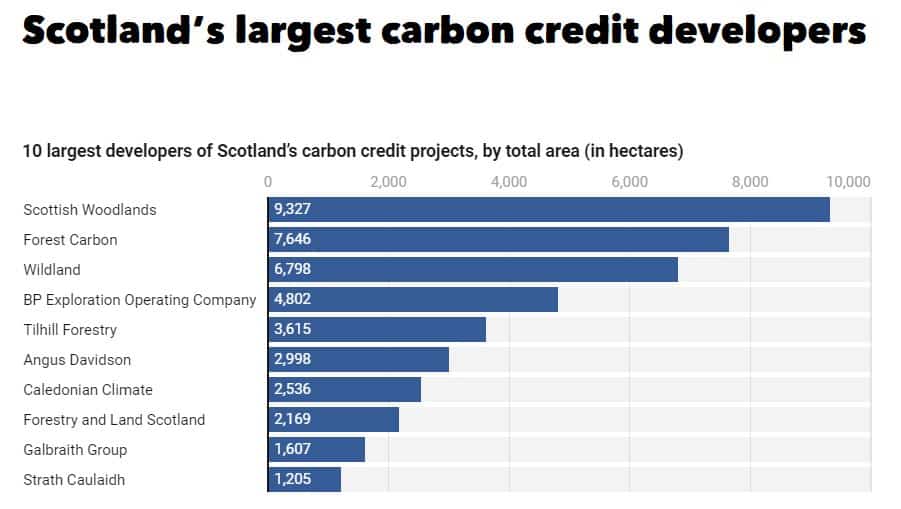As pressure mounts to fight climate change, companies like Shell, Barclays, Thales, and FleetCor are turning their eyes on Scottish carbon credits to offset emissions. But critics claim this market scheme is causing “carbon capitalism” in the country.
Carbon credits are one of the major solutions that firms can resort to when tackling the climate crisis.
Proponents of this scheme argue that the credits attract private investments into nature-based restoration projects by putting value on emissions reductions. But opponents claimed that the credits are a “false solution” to the climate crisis.
Scotland is appealing to developers of carbon credits because of its large rural land area for tree planting.
The country also has a lightly regulated land market and generous government subsidies for woodland and peatland projects that produce the credits.
Scottish Carbon Credits
The previous United Nations Climate Change Conference (COP26) was held in Glasgow last October to November in 2021. Article 6 which governs the structure of carbon credits was at the top of every country’s agenda during COP26.
In the UK, the Woodland Carbon Code (WCC) – administered by the Scottish Government agency Scottish Forestry – sets out the design and management requirements for voluntary carbon sequestration. The Code allows independent registration and verification of tree planting projects.
- Verified woodland carbon units are one type of credit that a firm can use to voluntarily offset emissions under UK government guidance on demonstrating carbon neutrality.
But they can’t use the credits in international carbon reduction mechanisms like the EU Emissions Trading System.
The Scottish Government has been promoting the use of Scottish land for creating carbon credits. It commits itself to tackle the ill effects of scale and concentration of land ownership.
The government also views private investments as an enabler of addressing climate change and restoring nature.
The other carbon credits scheme operating in Scotland is the Peatland Code. It covers the peatland restoration projects that generate credits.
Some experts in land reform said that demand for carbon credits contributes to rising land prices across the nation, causing an unjust land market. Land values reportedly jump by 61% in 2021 alone due to demand from forestry investors.
The chart below shows the major carbon credit producers in Scotland. Edinburgh-based Scottish Woodlands topped the list.

Major Buyers of Carbon Credits in Scotland
About 560,000 credits produced by Scottish projects have been sold to date. Each credit represents one tonne of CO2 avoided or removed by a woodland or peatland project.
According to an analysis, the largest buyer of Scottish carbon credits is FleetCor, an American firm selling fuel cards to the haulage sector. It purchased around 390,000 credits, which are over half of credits sold so far by woodland projects.
- Other major credit buyers are banks, insurance firms, and major investors. Together they bought about 30,000 credits to offset their operations in the UK.
One of them is Barclays that has invested ~£100 billion in oil and gas firms since the Paris Agreement.
Baillie Gifford, which has invested in fossil fuels and has a major stake in a big oil producer, is also on the buyer’s list.
The oil giant Shell, which has been pouring billions of dollars into carbon removal projects, has bought 635 credits only from woodland projects. That little amount is to offset a small part of its emissions from a rewards scheme for motorists.
Two weapons manufacturers are also opting for credits to offset their unavoidable emissions.
One is Thales, a manufacturer of unmanned drones, that has bought 2,735 carbon credits.
The other arms firm making it to the top 20 buyers of Scottish carbon credits is Babcock. It used the credits to offset emissions from a fleet of non-combat vehicles it runs for the UK Ministry of Defence.
- Scottish carbon projects will absorb a total of about 14 million tonnes of CO2 across their lifetime.
That equates to the same amount of carbon credits, including the units that are not yet sold on the market.
The figure is too small in comparison to the country’s total emissions from the source in 2020 – 40 million tonnes.
Plus, it accounts for only 1% of Shell’s emissions alone in a year. But it requires a land area larger than 3 Scottish biggest cities combined.
The Controversy Surrounding the Credits
Environmentalists called carbon credits a false solution to the climate crisis. That’s because some projects may take decades to deliver the reductions that a carbon offset promises.
Add to this the fact to their claim that tree planting doesn’t provide permanent CO2 capture and storage. When the trees die or burn, the carbon they store gets released back into the atmosphere.
Offsets also need a huge amount of land to reduce global emissions.
- If we’re to achieve net zero emissions by planting trees alone, it requires a land area 5x bigger than India.
Lastly, the changing land market with exploding prices makes it harder for small land buyers to raise enough capital. A researcher said that:
“The average price last year of a Highland estate, those being bought for carbon offsetting, rose to £8.8m, an increase of 87% on the year before. Seven sold for over £10m… This demand is driven by increased government support for environmental measures and a rise in interest from corporate buyers with large balance sheets.”
For others, buying credits can serve as an excuse for avoiding harder measures to cut emissions from a firm’s internal operations.
While for a former Scottish official, the carbon credit market highlights the wealth inequality in the country. That’s because the more Scottish carbon credits that international firms buy, the less remains for the country’s own offsetting needs.
But carbon credits are not inherently bad and the world needs them as a tool to avoid/reduce emissions. And while their real environmental benefits may appear dubious, the global market for carbon credits will balloon by 2050.
-
It’s expected to be worth $100 billion in the UK alone.
This projection is reflected in a massive rise in demand for Scottish land for offsetting purposes by large private investors.
As per the landowners that generate Scottish carbon credits, private investment in carbon projects led to:
“significant land use change” and were “not a short-term money making enterprise”.
For the former Scottish Environment Protection Agency chief executive, carbon sequestration was always intended to offset hard-to-tackle emissions as Scotland approaches net zero in 2045.
This summer, the Scottish Ministers will consult on a wide range of proposals for the government’s ambitious new Land Reform Bill to be introduced by the end of 2023.
Chair of the Scottish Land Commission Andrew Thin said that:
“The ways land is owned and used is central to tackling the climate emergency, contributing to a successful economy and supporting communities. It is great to see the Government launch the consultation of the upcoming Land Reform Bill. It includes a range of potential measures to ensure that the benefit of land is shared by all.”

